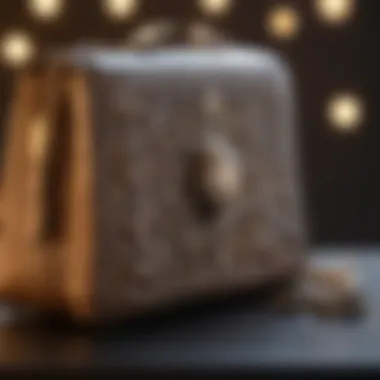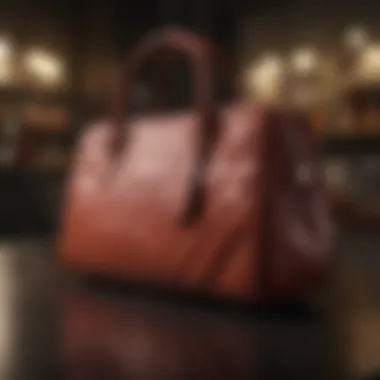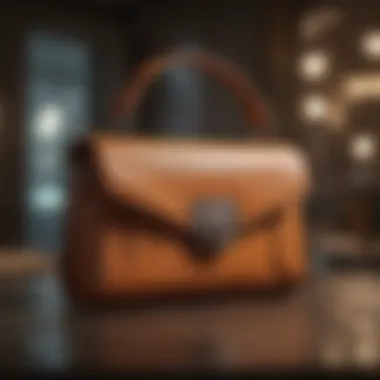Trending Purse Brands: Insights into Fashion's Favorites


Intro
In recent years, the purse market has undergone a significant transformation. Consumers are no longer just choosing bags based on functionality or brand prestige; emotional connection, aesthetics, and sustainability are now equally important factors. This adds a new layer of complexity to an already diverse and enriching field of fashion accessories.
The purpose of this article is to provide a thorough examination of current trends among purse brands. As we are about to see, a blend of emerging designers and established luxury houses plays a central role in shaping consumer preferences today. Various dynamics can be attributed to heightened interest, with social media being a powerful influence, as it not only introduces products but also cultivates brand narratives.
Through this analysis, key insights will be gleaned about what shapes the decision-making process of purse buyers today. Awareness of brand value, ethical considerations, and the latest market shifts is crucial for those in the fashion industry and consumers alike. This is not merely a survey of what is prevalent but a avenue into understanding the cultural elements at play in the fashion space.
Let us now dive deeper into the landscape of trending purse brands.
Overview of the Purse Market
Understanding the purse market is essential for anyone involved in or observing fashion trends. Purses symbolize more than just accessories; they reflect personal style, social status, and functionality necessities. The category of purses encompasses a wide range of products from luxury to everyday items. In this analysis, we examine the broader aspects that shape the creation, consumption, and overall significance of purses in today's marketplace.
Historical Context
The evolution of purses can be traced back to historical shifts in fashion, gender roles, and practical needs. Initially, purses emerged as purely utilitarian objects. Their purpose was to carry essential items, such as currency and personal belongings. Over centuries, as societies progressed, the design and materials used in purses changed. Pursuses started incorporating stylish elements, becoming pivotal in fashion culture. Luxurious brands like Chanel, which launched its iconic 2.55 bag in 1955, shifted the narrative around handbags to symbols of prestige and craftsmanship.
Significantly, women's rights movements also influenced purse designs. As women entered workforces and claimed independence, purses evolved to reflect this new social climate, offering a blend of style with purpose.
Current Market Trends
Today, the purse market operates in a dynamic environment. Several key trends highlight current preferences:
- Sustainability: Eco-conscious production methods are rising in demand. Consumers increasingly seek brands that use sustainable materials and ethical practices.
- Technology Integration: Smart purses with tech features, like charging ports or security alarms, are gaining traction.
- Street Style Influence: Brands respond to the desire for unique designs that resonate with urban settings. More individuals lean towards bags that stand out in everyday environments.
- Fast Fashion: Accessibility and price remain driving factors. Chains like Zara and H&M continue to dominate by providing trendy and budget-friendly options.
Importantly, social media plays a colossal role. Platforms like Instagram dictate purse desirability. Individuals frequently sample styles initially exposured by influencers. This reflects a broader cultural shift; purchases are influenced deeply by online trends rather than exclusive boutiques alone.
The purse market's adaptation results in it not just being an industry but a cultural conversation where functional design meets artistry and self-expression.
Defining Trends in Purse Brands
Understanding the trends shaping the purse industry is crucial for grasping consumer preferences and the dynamics that drive purchases. This section elucidates significant trends that are not only redefining brands but also influencing customer behaviors. Trends in both style and production highlight shifts in consumer values, behavioral patterns, and market demands. Identifying these trends grants insight into buyers’ choices while revealing the industry’s evolution in response to these shifts. The emerging themes focus on factors like sustainability, personal touch in product offerings, and the power of street style influence.
Sustainability and Ethical Production
As consumers become more aware of their impact on the planet, sustainability has emerged as a key trend among purse brands. Manufacturers are implementing eco-friendly practices and creative methods to produce stylish products without harming the environment. Car brands and purses alike are prioritizing materials like organic cotton, recycled plastics, and ethically sourced leather. Companies are reflecting on their supply chains, ensuring that labor practices are fair and beneficiaries are well-compensated.
Sustainability does not only serve moral purposes; it can also increase customer loyalty. People tend to support brands that align with their values. Investing in sustainably-made products mean investing in the future. Brands such as Staud and Pact are fine examples of this trend, providing consumers with attractive and responsibly-made options.
Customization and Personalization
The demand for individuality is strong among modern consumers. Customization in product offerings enables buyers to reflect their personal style and narrative through their purse choices.
This desire for personalization translates into creative collaborations, limited editions, or options to personalize colors, patterns, and monograms. Louis Vuitton, for instance, has long offered clients the chance to add initials or symbols to bags, which enhances emotional connections to their products. As a result, the purse acquiring experience becomes intimate and via its unique attributes. Moreover, the focus on personalization accounts for rising brand differentiation in an increasingly competitive market.
Influence of Street Style
The power of street style in shaping consumer choices is undeniable in the fashion world. Street fashion reflects authenticity, and it often serves as a bridge between high-fashion and everyday wear. Today's leading influencers curate diverse styles borrowed from different cultures and lifestyles, offering savvy consumers guidance. Social media platforms assist in leveraging street styles, making them accessible; platforms enable immediacy of trends, showcasing how people across the globe style their bags.


High-impact celebrity endorsements and influencer promotions can also galvanize interest in varying brands, making some products iconic. In essence, the intersection of fashion and street style empowers consumers to curate their wardrobes, bringing luxury items into everyday contexts, while paving the way for lesser-known brands to emerge, exploiting this fascination creatively.
The continuous influence of street style showcases how less of a distinction there is between runways and daily life, elevating increasingly democratic access to fashion trends globally.
Across the discussed elements, it becomes apparent that consumer preferences are easily swayed by trends rooted in society. Companies that understand and adeptly respond to these changes can thrive and connect deeply with their audiences.
Prominent Purse Brands
The discussion surrounding prominent purse brands is crucial in understanding current market dynamics and consumer preferences in the fashion industry. These brands have shaped the purse market and hold significant cultural relevance today. They range from established luxury labels to more accessible fast fashion retailers and emerging brands seeking to carve a niche. Analyzing these brands provides insights into the varying segmentations of the market and caters to differing consumer demands.
Luxury Labels Revisited
Chanel
Chanel has a storied legacy in fashion, famous for its timeless designs and high-quality materials. One key characteristic of Chanel's offerings is its classic elegance, exemplified by the iconic Chanel No. 5 perfume and the Chanel Classic Flap Bag. This luxury brand is a beneficial choice for those investing in a purse that symbolizes status and sophistication. The unique feature of Chanel lies in its commitment to craftsmanship; each piece is intricately designed, ensuring longevity. However, one disadvantage may be the accessibility—high price points limit the consumer base.
Louis Vuitton
Louis Vuitton is synonymous with luxury and monogrammed handbags. A fundamental aspect of Louis Vuitton is its history and its carefully cultivated image. Often deemed quite favorable among luxury consumers, its products are characterized by durability and a strong brand identity. Much like Chanel, Louis Vuitton invests heavily in artisanal methods to create its products. Notably, an advantage is the resale value of LV bags, which tends to maintain or even increase over time. On the downside, the popularity of the brand has led to significant counterfeiting.
Gucci
Gucci represents a fusion of classic design with modern trends. This Italian brand has used controversy and artistic innovation to remain pertinent in today's market. One prominent characteristic of Gucci is its bold, eclectic style that appeals to a younger demographic seeking to make a statement. The unique feature of Gucci is its ever-evolving designs driven by creative directors like Alessandro Michele. While this keeps Gucci fresh in consumers’ minds, continuous change can alienate traditional consumers who prefer the brand’s original aesthetic.
Fast Fashion and Accessibility
Zara
Zara has risen as a swift player in fast fashion by offering trendy styles at affordable price points. An essential aspect of the brand is its ability to replicate high fashion looks almost immediately. This speed appeals greatly to young consumers who want current trends without waiting. Zara’s unique feature lies in its store strategy, turning over designs frequently. However, a potential disadvantage could be concerns over sustained quality as products are mass-produced.
H&
H&M is one of the giants in affordable fashion, successfully covers a variety of styles, which makes it a go-to for many shoppers. One key characteristic of H&M is inclusivity in sizes and styles. This makes it a beneficial option for a wide demographic. The brand often uses recycling in their collections, appealing to eco-conscious consumers. Still, the major drawback can be related to quality and longevity compared to more luxurious counterparts.
Forever
Forever 21 appeals to a youthful audience by offering current fashions at very low prices. The key characteristic of Forever 21 is its vast selection, catering to diverse styles and tastes. Featuring a constantly updated inventory, it engages committed fashion enthusiasts looking for bargains. On the flip side, buying from fast fashion retailers comes with ethical concerns regarding labor practices and environmental sustainability, which consumers are increasingly cautious about.
Emerging Brands on the Rise
Staud
Staud is quickly gaining recognition for its innovative designs, often incorporating unique textures and shapes. One characteristic of Staud is its ability to blend classic silhouettes with modernity, appealing to fashion-forward shoppers. The unique feature here is the brand’s playful yet sophisticated approach, differentiating it from traditional competitors. It has manageable pricing, which makes luxury look accessible. However, upcoming genres still face longer building periods compared to established brands.
Rejina Pyo
Rejina Pyo emphasizes sustainability, creating distinctive pieces aimed at conscious consumers. A notable characteristic of this brand is its focus on thoughtful design and limited production runs, which already resonate with customers looking for quality. The unique feature is the immediate response to ethial production practices. Despite its growing popularity, larger retail presence still needs to expand to reach wider audiences.
Pact
Pact is emerging as a pioneer of sustainability within the fashion space. Known for its organic cotton products, its core focuses revolve around ethical production. The essential quality of Pact is its alignment with values that resonate with today’s shoppers—thoughtful practices in terms of both labor and materials. Nonetheless, balancing eco-friendliness with great design continues to be a challenge for many newer entrants in the clothing industry.


What we see in this segment of purse brands demonstrates not only the range of styles available but also showcases varying values among consumers, from durability and fashion sensibility to ethical production.
Digital Influence on Purse Branding
The influence of digital channels on purse branding has transformed the fashion landscape. As the digital age progresses, brands must navigate this complex environment to remain relevant. With consumers increasingly looking online for their purchasing decisions, knowing how to interact effectively across platforms is paramount.
Role of Social Media Campaigns
Social media is a powerful tool in the arena of marketing. It's no longer just about traditional billboards or fashion shows anymore. Brands like Chanel and Gucci are tapping into this resource to connect with potential buyers.
Benefits of Social Media for Brands:
- Wider reach, accessible to diverse demographics.
- Instant feedback from consumers.
- Interactive content creates deeper engagement.
- Easy to share user-generated content.
Brands employ tailored campaigns to foster connection and community. Collaborating with graphic designers and social strategists, they can create visual blood that resonates today. Videos, spontaneous posts, and challenges attract viewer interest while driving sales. Such strategies facilitate a direct line to consumers, allowing luxury brands, emerging players, and fast fashion to compete on similar ground. It's an effective battle for consumers’ minds and dollars. Using the hashtag #FashionInYourHands or similar, brands can zorgen for user content.
Influencer Collaborations
Influencers bridge the gap between brands and consumers. Partnerships have proliferated within this channel, making it a prevalent strategy. Brands like Off-White and Fendi have formulated product launches around influencers, leveraging their clout to enhance visibility.
Influencers generate such success through:
- Established trust with followers, thus enhancing authenticity.
- Highlighting products verbally and visually increases desirability.
Not only do these partnerships boost credibility, they also draw attention to both the hardware and the lifestyle the brand represents. Data suggests that this form of marketing is not only effective but necessary to gain traction in the current climate. Cooperation and collaboration give brands leverage greater than what was traditionally available, that lovely access. Some examples include promotional events, exclusive product lines, and personal stories that tell consumers about specific products and trending topics in real time.
“You have to understand that not everything is visible. The interaction through influencers often alters consumer perception at first glance.”
As the landscape of purse branding continues to evolve, the relationship between digital influence and consumer connectivity will undoubtedly become as crucial as the product itself.
Consumer Behavior and Preferences
Understanding consumer behavior and preferences is essential in the context of purse brands. As the market is flooded with options from luxury to emerging brands, buyer decisions can be complex. Their choices are influenced by various factors, including functionality, aesthetics, social media presence, sustainability, and brand reputation.
The significance of recognizing these aspects lies in how brands can tailor their products to meet customer needs more effectively. A firm grasp of consumer behavior helps manufacturers to develop strategies, make informed decisions, and remain competitive in this elastic market.
Prioritizing Functionality vs.
Aesthetics
Functionality and aesthetics often stand on different sides of the consumer's preference scale when it comes to purses. Some consumers might lean heavily toward a purse's practical aspects, such as material quality, storage capacity, and weather resistance. For these shoppers, a purse must provide more than just visual appeal; it needs to serve its intended purpose efficiently. In contrast, others might prioritize aesthetics, focusing on color, design, and brand prestige even if it might sacrifice some functional capabilities.
Functional elements of purses that often attract buyers include:
- Durability and quality materials.
- Adequate storage options like compartments and pockets.
- Comfort in carrying, including strap length and handle design.
Both aspects must coexist without compromising the creative vision and overall buying experience. Understanding the balance between these two dynamics can assist manufacturers in targeting distinct audiences effectively.
Understanding Purchase Drivers


The fundamental drivers behind consumer purchases can be intricate. A deep dive into psychological, societal, and economic factors reveals the true motivations behind why consumers buy certain types of purses.
Below are crucial aspects that influence buying decisions:
- Brand Loyalty: Customers often prefer brands with which they have built trust over time.
- Social Influence: Recommendations from peers or influencers have significant impact. Many consumers follow style trends highlighted by popular figures on social media platforms.
- Price Sensitivity: The price point can affect the target demographic, often leading to a divide in luxury vs. fast-fashion products.
- User Reviews: Feedback from others can sway decisions and encourage new buyers accross brand lines.
A comprehensive understanding of these drivers assists brands in designing marketing strategies that resonate with their target audience, ensuring successful engagement with potential buyers. Companies that analyze these dynamics can clearly tune their approaches to satisfy the ever-evolving tastes and expectations of consumers in the purse market.
The Economic Impact of Purse Brands
The economic significance of purse brands extends beyond mere accessory lines. In the global landscape of fashion, these brands wield an influence that shapes retail markets, consumer behavior, and employment within related industries. The comprehensive potential of this segment lies in its capacity to not just drive revenue, but also to reflect shifts in consumer values and economic cycles.
Market Size and Growth Potential
Recent studies indicate growing interest in the purse sector, which is evident in its expanding market size. According to research from various industry analysts, the global handbag market was estimated to surpass $60 billion in 2022, with a projected annual growth rate of 4% to 6% over the next few years. This growth is multifaceted, driven by various factors, including increasing disposable income, a burgeoning middle class, and the rising trend of luxury spending in emerging economies.
The segment of sustainable purses also plays a notable role. Many brands are anticipating demand for eco-friendly materials and ethical practices, appealing to conscience-driven consumers. This shift can be seen in notable lines from established designers who are unveiling collections made from recycled materials.
Factors influencing expansion also include:
- Brand Collaboration: Partnerships with influencers or cross-industrial collaborations create fresh narratives and attract attention to new products.
- Retail Presence: The growing accessibility of both brick-and-mortar and online boutique experiences allows consumers a firsthand view, accentuating brand desirability.
Effects of Global Events on Sales
The purse market, like many consumer sectors, shows notable sensitivity to global events. Pandemic-related disruptions dramatically affected retail sales and consumer behaviors. During lockdowns, many luxury brands faced severe declines, while casual and lifestyle brands reported an uptick. This trend leads to broader implications regarding how global events can dictate fashion preferences and purchasing decisions.
Another critical point is the influence of economic fluctuations. In times of recession, luxury handbag sales often drop as consumers re-evaluate their spending. Conversely, moments of economic recovery typically see a resurgence in luxury purse sales, indicating that emotional and psychological factors strongly impact buying choices.
Emerging difficulties also emerge from geopolitical tensions. Tariffs and trade restrictions, for instance, can directly affect pricing and merchandise availability in many markets, ultimately leading to complications in brand loyalty and consumer trust. In addition:
- Consumer Adjustments: Buyers may select more affordable options in response to rising prices in luxury sectors.
- Innovative Responses: There's a push among brands to explore new markets, perhaps through innovative sales strategies or by attuning collections to regional tastes.
Understanding these economic intricacies is essential for investors, brands, and consumers alike, as they navigate through changing landscapes and anticipate future trends.
Future Trends in Purse Brands
Understanding the future trends in purse brands is vital for anyone interested in the fashion industry. It offers insight into how brands will adapt to shifting consumer preferences, technological advances, and the overall economic climate in coming years. This section will explore two crucial aspects influencing future developments: tech-driven innovations and changes in consumer values.
Tech-Driven Innovations
Technology continues to influence various industries, including fashion. In purse design and production, several innovations are key to watch:
- Smart Features: Many brands are integrating technology into bags. Like tracking features that helps users locate their purse, or integrated chargers for devices, to appeal to tech-savvy consumers.
- Sustainable Fabrics: As sustainability remains a priority for consumers, companies are exploring new materials. Eco-friendly textiles, developed using reduced resources, are becoming more popular.
- Augmented Reality (AR): Augmented reality is reshaping how consumers shop for purses. Through apps, buyers can visualize how different bags will look with their outfits without physically trying them on.
These innovations present opportunities for brands, enabling them to tap into new markets and meet evolving consumer needs more effectively. Staying competitive means adapting to such changes in a timely manner.
Market research suggests that consumers are interested in products that combine functionality with modern technology, thus increasing brand loyalty.
Changes in Consumer Values
Consumer values shape many industries, especially in fashion. Today, there are noticeable shifts that influence purse brands significantly:
- Emphasis on Sustainability: Modern shoppers do care nabout the environmental impact of their purchases. Brands are under pressure to provide transparency in their production processes.
- Authenticity and Trust: Buyers prefer brands that represent genuine narratives and philosophies that resonate with them. This means embracing storytelling within marketing efforts.
- Diversity and Inclusivity: Consumers expect brands to cater to diverse backgrounds and body types. Collections that reflect varied needs appeal to a broader audience.
- Investment Pieces vs. Fast Fashion: With a shift toward quality over quantity, many consumers opt to invest in select premium pieces instead of trends from fast fashion outlets.
Each of these evolving values can change how brands approach product development and marketing strategies. The need to align with customer beliefs becomes crucial for retention.
In considering these future trends in purse brands, one can appreciate how responsive the industry is to broader societal shifts. To stay relevant, brands must not only embrace change but also predict where consumer demands are headed.







